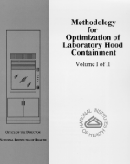Page Content
 |
Principal Investigator: Farhad Memarzadeh
Division of Technical Resources
Office of Research Services
National Institutes of Health
Bethesda, Maryland
November 1996 |
 |
How To Use This Document
This document is divided into two volumes. Volume I describes the project and its findings while Volume II presents summary data for more than 250 configurations investigated.
Volume I is divided into four parts:
| I. Introduction |
II. Methodology |
| III. Modelling |
IV. Results and Discussions
|
Section I provides background information that will aid understanding of the project objectives and scope. This should be read by all.
Section II provides an explanation of the methodology used. In particular, it provides a basis for those with no knowledge of computational fluid dynamics and the analysis approach used to determine hood performance. It should be used as background for designers simply using the recommendations to improve their designs. It is essential reading for people wishing to compare their laboratories with those considered in this study and for people intending to extend this research. Section III describes the computational fluid dynamics models for the configurations. It is essential reading for all since it fully defines the scope of the work undertaken in this project and thus the applicability of its findings.
Section IV presents the outcome of this research. It is divided into seven parts as follows:
| 4.1 Presenting the results |
4.2 Single hood simulations - general analysis |
| 4.3 Specific configuration recommendations |
4.4 Experimental verification |
| 4.5 Using the research data - ranking and comparison |
4.6 Summary of recommendations |
| |
4.7 Future research |
The results of this research are intended for use in one of four ways:
- In conjunction with current design practice as additional recommendations. In this case, the designer should read sections 4.1, 4.2, 4.3 and 4.6 and follow the recommendations as given in sections 4.3 and 4.6.
- In identifying the likely performance of a proposed or existing configuration from the research data. In this case, sub-sections 4.5.1 to 4.5.3 are critical along with sections 4.1, 4.2 and 4.3 providing necessary background information. Sections 4.3 and 4.6 may be used to improve a proposed design.
- In identifying the performance of an existing laboratory configuration experimentally. In this case, the investigator should read section 4.4 along with sections 4.1, 4.2 and 4.3 providing necessary background information.
- In supplying necessary information for those who wish to make a more fundamental comparison of their own design with those presented here, or as a database of information for any who wish to continue research into the effect of laboratory air flow on hood containment. In this case, the remainder of sections 4.5 and 4.7 should be reviewed.
Volume II provides a summary of results from the different analysis methodologies for each simulation, however, only the leakage method is adopted for the assessments made here. Where appropriate in Volume I, a pictorial approach is used to show the specific differences for different configurations as an approach complimentary to the quantitative leakage assessment. We recommend an HTML 2.0 compatible browser & a PDF helper application to view these pages.